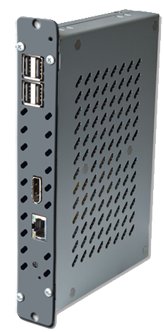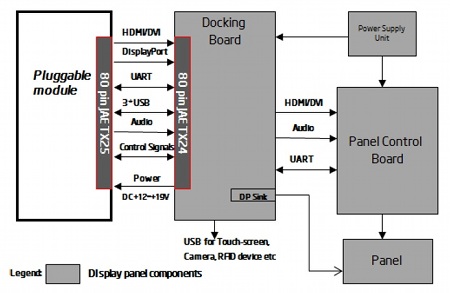Signage module uses dual-core AMD processor
Jun 27, 2011 — by LinuxDevices Staff — from the LinuxDevices Archive — 12 viewsNEC unveiled a computing module that complies with Intel's Open Pluggable Specification (OPS) for digital signs but uses an AMD processor. Designed to slot into the back of the company's displays, the SB-02SC includes a dual-core T56N processor, has either a 32GB solid state drive (SSD) or a 160GB hard disk drive (HDD), and comes in a Windows 7 version as well as a barebone version that supports Linux.
Last year, Intel announced its Open Pluggable Specification (OPS), a standardized design for digital signage computers. At the time, not much information was revealed publicly, but the chipmaker said the OPS would involve the use of its Core processors along with Microsoft's Windows Embedded Standard operating system.
NEC, an early supporter of the spec, announced an Intel Core i5-based, Windows-only POS module, the N8000-8330, earlier this month. At the time, we found a placeholder entry on the company's digital signage website suggesting (to our surprise) that NEC was also planning an AMD-powered OPS device.
Now, NEC has announced this as the SB-02SC, confirming that nothing in the OPS spec (see later in this story for background) mandates use of an Intel CPU. It turns out that despite what was implied last year, OPS modules don't have to run Windows, either; NEC offers Windows 7 Professional for the device but also sells a barebones version for those who want to install Linux.
 The SB-02SC (pictured) is a 7.1 x 4.6 x 1.2-inch module designed to slot into the back of "select NEC X, P and V Series displays, including the new V462, P402 and P462." It incorporates a dual-core AMD T56N processor (with Radeon HD6310 graphics), 2GB of RAM, and either a 32GB SSD or a 160GB HDD.
The SB-02SC (pictured) is a 7.1 x 4.6 x 1.2-inch module designed to slot into the back of "select NEC X, P and V Series displays, including the new V462, P402 and P462." It incorporates a dual-core AMD T56N processor (with Radeon HD6310 graphics), 2GB of RAM, and either a 32GB SSD or a 160GB HDD.
According to NEC, the device has a gigabit Ethernet port, four USB 2.0 ports, an internal RS232 connection for integrated display control, and a DisplayPort output for a secondary display. Unlike the fancier N8000-8330, however, it does not appear to include audio output.
Intel had touted fanless operation for OPS devices, but NEC's N8000-8330 incorporates a cooling fan. The SB-02SC, on the other hand, does appear to be fanless, though NEC provided no confirmation in this regard.
According to NEC, the SB-02SC works in temperatures from 32 to 104 deg. F. The three-pound device uses 16VDC input power and consumes a maximum of 35 Watts, the company adds.
More about the Open Pluggable Specification
As we've mentioned, Intel didn't reveal much about the Open Pluggable Specification when it was first announced last October. A December blog entry clarified matters as follows, however.
According to the posting, OPS defines a standardized module and related interconnections "to insure compatibility and ease of integration between digital signage components from multiple vendors." As shown below, the standard specifies an off-the-shelf 80-pin JAE Electronics TX24/TX25 blind mate plug and receptacle connector system to interface the pluggable module and the display.

A diagam of Intel's Open Pluggable Specification
(Click to enlarge)
The pluggable module itself consists of a printed circuit computing board housed in a protective wrapper chassis, Intel adds. The circuit board should be equal to or smaller than the EPIC (Embedded Platform for Industrial Computing) standard size of 115 x 165mm, and the overall dimension of the module including the mounting frame is 200 x 119 x 30mm, the company says.
It's said the OPS standard also defines the interface signals for all 80 pins of the JAE connector. For example, power input is specified as 12~19V DC at less than 4A and is spread over multiple pins to stay within the connector's maximum current rating. Other pins carry the digital signals for interface to the display, including HDMI, DVI, DisplayPort, audio, serial, plus provision for both USB 2.0 and USB 3.0, according to Intel.
According to Intel, the OPS standard also includes thermal specifications and details cooling requirements for modules based on the Core i7 processor and QM57 chipset. The company adds, "Although it is not required by the specification, installing digital signage equipment based on Intel architecture helps you implement scalable digital signage applications that can network easily with other equipment."
Further information
According to NEC, the SBC-02SC will be available in July, and the SSD and HDD versions will be priced identically. Windows 7 Professional-equipped versions will sell for $949, while the barebones versions that support Linux will be $800, the company says.
More information on NEC's OPS devices may be found on the NEC option cards page and the SB-025C product page.
Jonathan Angel can be reached at [email protected] and followed at www.twitter.com/gadgetsense.
This article was originally published on LinuxDevices.com and has been donated to the open source community by QuinStreet Inc. Please visit LinuxToday.com for up-to-date news and articles about Linux and open source.